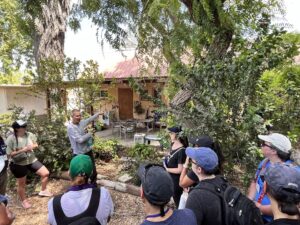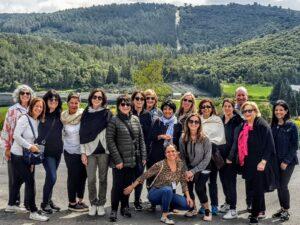Almost every tour guide in Israel has quoted the well-known two-part poem “Tourists” by Yehuda Amichai. In the first part Amichai cynically describes the way he perceives how tourists relate to being in Israel:
Visits of condolence is all we get from them.
They squat at the Holocaust Memorial,
They put on grave faces at the Wailing Wall
And they laugh behind heavy curtains
In their hotels.
They have their pictures taken
Together with our famous dead
At Rachel’s Tomb and Herzl’s Tomb
And on the top of Ammunition Hill.
They weep over our sweet boys
And lust over our tough girls
And hang up their underwear
To dry quickly
In cool, blue bathrooms.
Amichai’s descriptions portray tourism as an act of objectification of places and people, as if a tourist can only play-act identification with this place. The expectation of emotions to be felt on a visit here sometimes even prescribes to tourists what they should feel. Obviously this poem could be insulting to anyone hearing it during a visit here and one might wonder what the point would be of a tour guide reading this poem to a group. Taken another way, the poem could be a warning to tourists not to act this way and the second half of the poem gives an alternative way of being a tourist.
The poem continues in the first-person:
“Once I sat on the steps by a gate at David’s Tower, I placed my two heavy baskets at my side. A group of tourists was standing around their guide and I became their reference point. “You see that man with the baskets? Just right of his head there’s an arch from the Roman period. Just right of his head.” “But he’s moving, he’s moving!” I said to myself: redemption will come only if their guide tells them, “You see that arch from the Roman period? It’s not important: but next to it, left and down a bit, there sits a man who’s bought fruit and vegetables for his family.”
Amichai puts the responsibility on the tour guide to be the conduit through which tourists can meaningfully and authentically engage with Israel. This is clearly one of the roles of the tour guide but the responsibility is a shared one. More and more, tourists are coming to Israel to engage, to meet the man who buys fruit and vegetables for his family, to hear the story of the daughter who serves in a fighting unit, to taste the foods that immigrants brought with them to this country. As much as the guide must nurture this way of looking at the country, the tourist must have as a goal to meet the country face to face, from within, to be active in not objectifying this country through touring.
How do we do this? The group participants and individual travelers to Israel since the events of October 7 have changed the paradigm. While there are still some ‘must see’ sites, even those having to do with the war, the true transformative experience results from meeting people and hearing their stories. People return to their homes talking about the people they met, describing the raw pain, fear, or hopefulness that they heard about. Tourists take back a sense of responsibility for bearing the weight of this situation and they also understand that the Israelis appreciate their role in bearing the burden of being Jewish in the diaspora. Let us continue to nurture this intimate way of connecting. We come to Israel now to meet the man with the food for his family, and while, yes, tourists are paying a condolence call, they are bearing witness and carrying this man’s story with them.
About the author: Ros Roucher has worked in Educational Tourism since moving to Israel in 2007, and currently serves as Lead Storyteller for Via Sabra. In her work and personal life, Ros feels privileged to encounter the diverse landscapes of Israel on a regular basis












